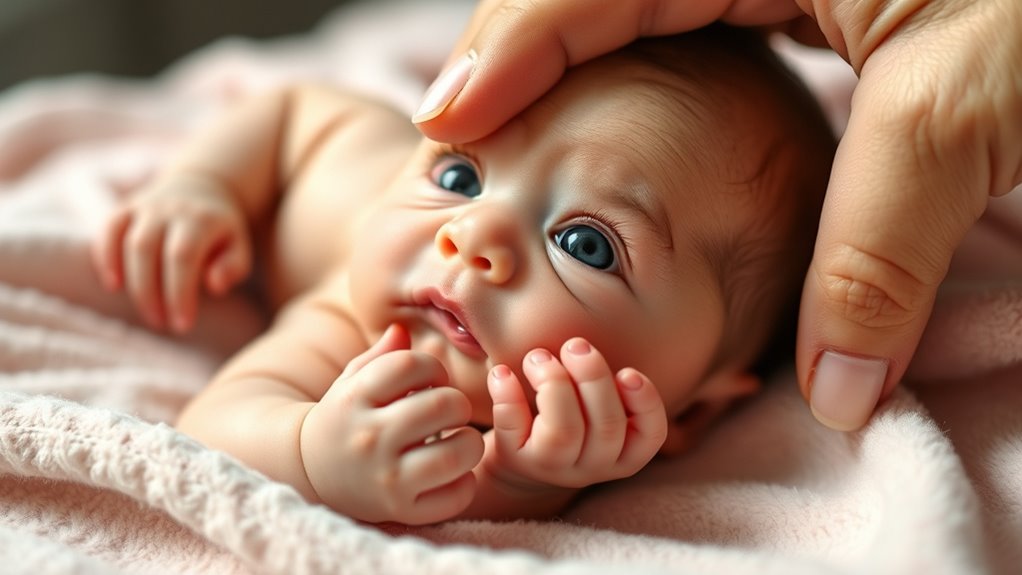If your infant shows rare signs like unusual eye flickering, sudden stiffening, or subtle twitching that doesn’t seem normal, it’s essential to act fast. Some seizures can be hard to spot but may signal underlying genetic or metabolic issues, especially if there’s a family history. Early detection through neonatal screening and recognizing these uncommon signs can make a big difference. Keep going to discover more about how to protect your little one.
Key Takeaways
- Rare signs include subtle eye movements, unusual postures, or brief episodes of unresponsiveness that may be overlooked.
- Genetic mutations affecting brain development can cause atypical seizure presentations in infants.
- Neonatal screening can reveal hidden metabolic or genetic disorders linked to seizure risk.
- Early signs like sudden stiffness or twitching, even if infrequent, warrant prompt medical evaluation.
- Recognizing uncommon symptoms helps parents seek timely diagnosis and prevent long-term neurological issues.

Have you ever wondered what causes seizures in infants? Understanding the underlying factors can help you act quickly and seek the right care. One of the significant causes is genetics. Some infants are born with genetic mutations or inherited conditions that increase the risk of seizures. For example, certain gene mutations can affect how the brain develops or functions, making seizures more likely. If there’s a family history of neurological disorders or epilepsy, your baby might be at higher risk. That’s why genetic causes are a critical piece of the puzzle when diagnosing and managing seizures in infants. Doctors often recommend genetic testing to identify these underlying issues, which can guide treatment options and provide clarity for parents.
Neonatal screening plays a essential role in catching potential problems early. When your baby is born, routine screening tests are performed to detect various conditions, including some that could lead to seizures if left untreated. These screenings can identify metabolic or genetic disorders, such as phenylketonuria (PKU) or certain amino acid disorders, which might not show obvious symptoms at birth but can cause seizures later if untreated. Early detection through neonatal screening allows healthcare providers to intervene promptly, often preventing serious complications. It’s important to follow through with all recommended tests and screenings, as they can alert you to hidden issues that may contribute to seizures. Recognizing early warning signs can be crucial for timely intervention and better outcomes.
Knowing that genetic causes and neonatal screening are linked can give you peace of mind, but it also emphasizes the importance of early diagnosis. If your infant exhibits any signs of seizures—like unusual movements, eye flickering, or sudden stiffness—prompt medical attention is essential. The sooner the cause is identified, the more effective the treatment can be. Sometimes, seizures in infants are temporary and related to fever or infections, but genetic and metabolic causes are often persistent and require targeted management. By understanding the role of genetics and neonatal screening, you’re better equipped to advocate for your child’s health, ensuring that potential issues are caught early and managed effectively.
Frequently Asked Questions
Can Seizures in Infants Be Hereditary?
You might wonder if seizures in infants can be hereditary. Genetic factors often play a role, meaning hereditary risks can increase the likelihood of seizures if there’s a family history of neurological conditions. While not always guaranteed, understanding your family’s health history helps your doctor assess risk and plan appropriate monitoring or treatment. Keep in mind, hereditary risks are just one piece of the puzzle—other factors may also influence seizure development.
What Are the Long-Term Effects of Infant Seizures?
You might wonder about the long-term effects of infant seizures, and it’s important to understand that they can impact your child’s development. Seizures may influence developmental milestones, leading to delays, learning difficulties, or behavioral challenges. Genetic predispositions can also play a role in recovery and future risks. While some children recover fully, others might need ongoing support, making early intervention critical to help your child’s growth and development.
How Can I Differentiate Seizures From Normal Infant Movements?
You can differentiate seizures from normal infant movements by observing specific signs. Normal infant movement patterns include gentle, spontaneous motions like stretching or random arm flailing. In contrast, distinguishing seizures involves sudden, repetitive, and jerky movements, often with a loss of awareness or eye fluttering. Pay attention to these differences, and if you notice unusual or persistent behaviors, consult a healthcare professional promptly for proper evaluation.
Are There Specific Triggers That Cause Infant Seizures?
You might think triggers are obvious, but often, infant seizures stem from hidden factors. Ironically, genetic predispositions and environmental factors quietly play a role, making it tough to predict when a seizure might strike. While no single trigger is guaranteed, exposure to certain stimuli or underlying health issues can increase risk. Staying attentive and consulting your doctor helps you understand these subtle influences and keep your little one safe.
When Should I Seek Emergency Medical Attention?
You should seek emergency medical attention if you notice any emergency signs during your infant’s seizure, such as the seizure lasting longer than five minutes, multiple seizures in a row, difficulty breathing, or unresponsiveness. If these signs occur, go to urgent care immediately or call emergency services. Acting quickly guarantees your baby gets the care they need and reduces potential complications. Don’t wait if you’re unsure—better safe than sorry.
Conclusion
Being aware of the rare signs of seizures in your infant is like holding a tiny lighthouse in a storm—guiding you through the uncertainty. When you recognize the subtle flickers or unusual movements, you’re taking essential steps to protect your little one. Trust your instincts and act promptly. With your watchful eye, you become their guardian, helping navigate through the dark clouds and guiding them toward safety and brighter days ahead.









